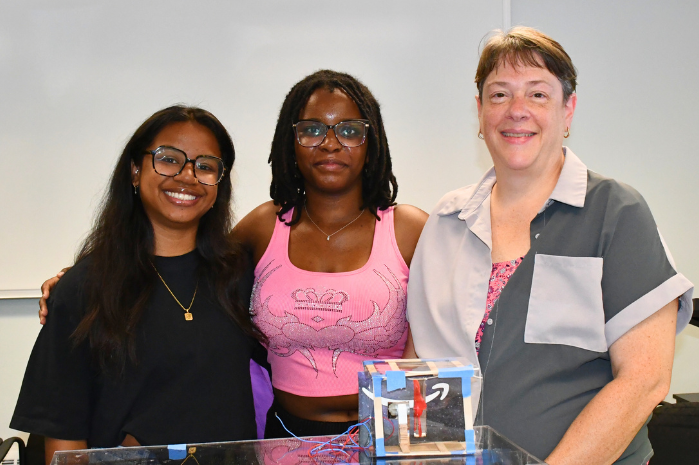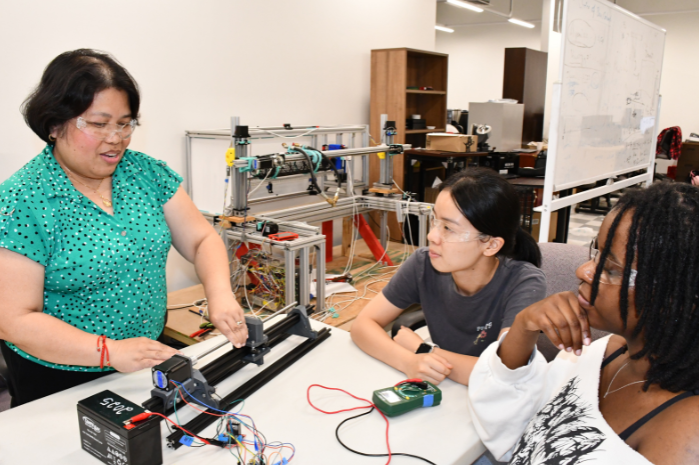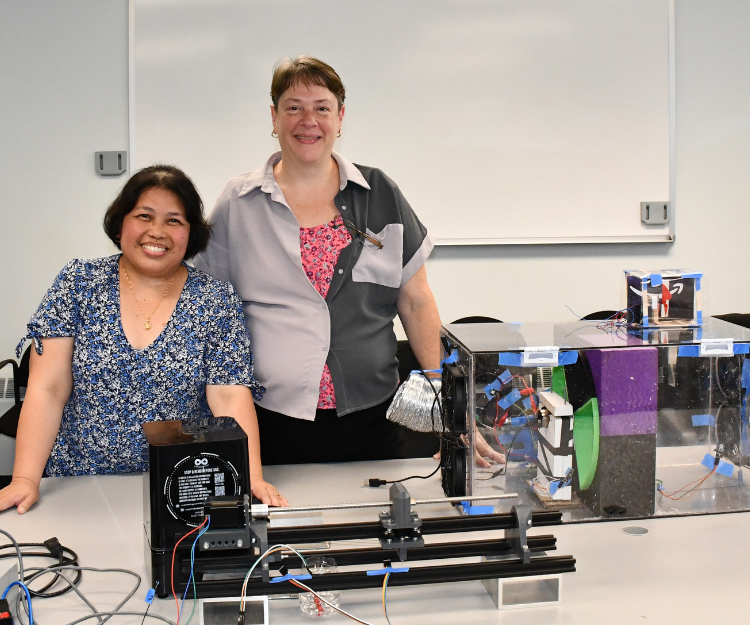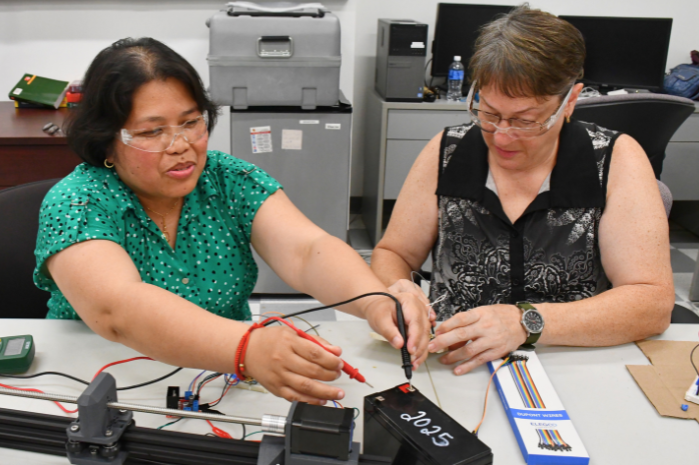UMD Provides "Cool" Research Experience for Two School Teachers
As a high school technology teacher, Karen Bogoski has coached over a thousand students through the challenges of engineering projects, but this summer, she was the one tackling a project, and her coaches were University of Maryland (UMD) engineering students. She worked at UMD’s College Park campus through four weeks of hot and steamy weather, while many other teachers were enjoying time off. But the muggy days only helped motivate her. Guided by a team of students from UMD's A. James Clark School of Engineering, Bogoski built a dehumidifier prototype that promises to be more energy efficient than today’s technology. Bogoski conducted her project through a Research Experiences for Teachers (RET) program that prepares K-14 educators to develop research-based curricula that inspire students to tackle real-world sustainability challenges. The RET program is offered through the Environmentally Applied Refrigerant Technology Hub (EARTH), a National Science Foundation-funded engineering research center that brings together six universities, including UMD, to develop more efficient and sustainable heating, cooling, ventilation, air-conditioning and refrigeration (HVAC&R) technology. Two other EARTH institutions – the University of Kansas and the University of Notre Dame – also offered RET opportunities this summer. Bogoski, along with fellow UMD participant Mildred Pates, teach at Eleanor Roosevelt High School, a science and technology magnet school just down the road from UMD in Greenbelt, Maryland. Both educators plan to incorporate their research into their lesson plans. “The RET program engages educators in hands-on research in sustainable technologies so that they can bring that perspective into the classroom and inspire the next generation,” said mechanical engineering Associate Professor Damena Agonafer, who heads the UMD EARTH team. “One of the reasons I even got interested in engineering was because of a class in seventh grade, where the teacher had a similar research experience.” Teaching the teachers Both Bogoski and Pates got an insider’s look at how UMD researchers are engineering the next generation of HVAC&R technologies to be more efficient and sustainable. “Current HVAC systems consume large amounts of energy,” explained graduate research assistant Andoniaina Randriambololona, who works in Agonafer’s Nanoscale Energy Interfacial Transport Lab (NEIT) and helped mentor the high school teachers. Improving energy efficiency is one of EARTH’s main thrusts. One solution might be right under our shoes, literally. Those little packets of silica gel tucked into boxes of new shoes are desiccants, materials that keep the merchandise dry. Under the guidance of NEIT’s researchers, Bogoski built a rotary wheel coated with desiccants for energy-efficient dehumidification. “The premise is that it will reduce energy consumption by 30 to 40% by separating the dehumidification process from the cooling process in today’s air-conditioning,” she explained. Bogoski and the UMD team tweaked a design previously proposed by a research group in the United Kingdom and then tested the performance of two different desiccants, silica gel and activated alumina. 
Mechanical engineering graduate student Andoniaina Randriambololona and electrical engineering undergraduate Iman-Louise Mwai supported teacher Karen Bogoski throughout her research. Bogoski developed a curriculum that challenges high school students to build a mini demudifier prototype. Turning theory into reality requires the type of determination that Bogoski tries to inspire in her high school engineering students. She faced a new challenge every day, from procuring materials, to 3D printing, to wiring and then rewiring her prototype when the motor failed to run. Along the way UMD students were there to support her. “They’ve been so helpful and informative,” said Bogoski, guiding her through her wiring frustrations and offering lessons on topics such as how to read psychrometric charts to understand the thermodynamics of moist air. Serving as a mentor gave Randriambololona, a third-year mechanical engineering doctoral student, a deeper understanding of the technical content and the best ways to communicate it. “There were some thought processes that I myself was still struggling with, which I couldn't really fully grasp until I had to teach it,” she said, pointing to psychrometrics as one of those areas. “When you have to explain something to someone, you have to make sure that you actually understand it.” Like many coaches, Randriambololona reveled in Bogoski’s success. “There’s a strong sense of pride in knowing I supported the teacher I worked with, and it was great seeing her thrive in the end. Knowing that I created a positive impact is a really good feeling.” Bogoski will bring her new knowledge back to the classroom. She is designing a curricular unit for her ninth-grade engineering course that focuses on the basics of air conditioning and engages students in a hands-on experience creating their own miniature rotary wheel desiccant dehumidifier. “The project falls right into what I teach in my classroom,” Bogoski said. “It brings in mechanical engineering, electrical engineering and computer programming.” As for her own research experience at UMD, “it’s exciting to think that I might have played some small part in developing a new technology that will help individuals by offering cooling and dehumidification at lower energy costs.”

Mildred Pates troubleshooted her engineering challenges with UMD engineering students, including materials science and engineering graduate student Boyang Liu and electrical engineering undergraduate Iman-Louise Mwai. Elastocaloric cooling leverages a group of metals called shape memory alloys (SMAs) that can be compressed and then stretched back to their original shape. SMAs release heat when compressed and absorb heat when relaxed, causing the temperature around them to drop. “It’s almost like a magical thing,” said Pates, a chemistry teacher. “I can use this kind of magic in my classroom.” The UMD project is led by Research Professor Yunho Hwang, with the Center for Environmental Energy Engineering, and Ichiro Takeuchi, professor and chair of the Department of Materials Science and Engineering. The research fits into another one of EARTH’s core thrusts, developing novel and safe refrigerants. While the UMD team has been investigating the elastocaloric cooling effect for over a decade, they haven’t delved into the dehumidification aspect until now. For Pates' project, she built an elastocaloric dehumidifier, based on a design proposed by another research group. The prototype uses nickel-titanium wire and doubles as a water harvesting device. 
High school teachers Mildred Pates and Karen Bogoski with their prototypes. “Going into this project, I knew about the issues with HFCs, but everything else was new to me. I learned so much,” said Pates, who is passionate about lifelong learning and recently earned a Ph.D. in science education from the University of Science and Technology of Southern Philippines. This is Pates’ second RET experience. In Summer 2022, through the Renewable and Sustainable Energy Technology RET program offered by the UMD Department of Materials Science and Engineering and funded by the National Science Foundation, she explored the green synthesis of silver nanoparticles using fruit wastes. “That experience really helped me in my classroom instruction and with my dissertation, so I was excited to participate in another RET,” Pates said. This summer she assembled the dehumidifier prototype in CEEE’s state-of-the art Daikin Energy Innovation Laboratory, leaning on the experts there for troubleshooting help. The project incorporated electronics and coding – areas that aren’t her forte as a chemistry teacher. “It was a privilege to get to work in the Daikin Lab,” Pates said. “I was blessed to work with a group of students and faculty who were always willing to help.” Pates’ mentors included graduate research assistant Boyang Liu, a fifth-year doctoral student in materials science and engineering. The program offered a learning experience for her as well. “It helped me learn more about using nickel-titanium, not just for cooling, but also for dehumidification,” said Liu. The UMD team is building a second version of the prototype, applying lessons learned from Pates’ system, and will test its dehumidification capacity in the lab. Pates is taking her prototype back to school for use in her chemistry classes. Through the RET program, she developed an inquiry-based curriculum that informs students about the environmental and efficiency concerns of today’s cooling technologies. She’ll then introduce elastocaloric cooling and give students an opportunity to test the prototype and discover how it offers a green solution. As Pates likes to say, “elastocaloric cooling turns stress into sustainability – teaching students that with the right materials and mindset, even pressure can produce progress." View the desiccant rotary wheel in motion.
Related Articles: August 11, 2025 Prev Next |
|


